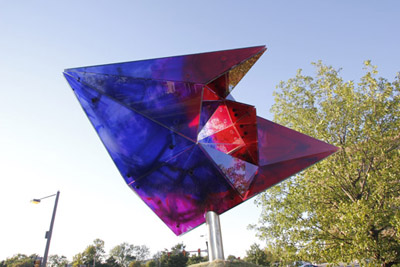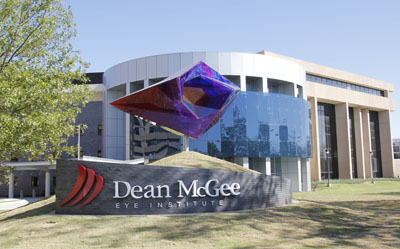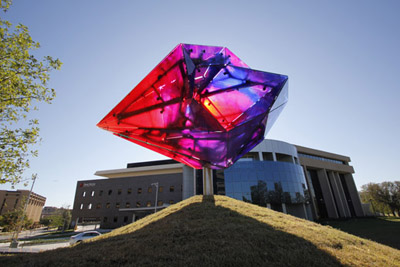 This glass public art sculpture was the result of a collaboration between an architect and a painter.
This glass public art sculpture was the result of a collaboration between an architect and a painter.
Architect Mark Dziewulski joined forces with Chinese-American visual artist Shan Shan Sheng to conceive of the winning proposal in response to a 2008 call for proposals for a public artwork outside the new Dean McGee Eye Institute (DMEI) in Oklahoma City, Oklahoma. Situated outside a center for the treatment and research of vision, eye care and education, a sculptural work that engaged the visual process would be important, and Dziewulski and Sheng’s proposal stood out from the more than 50 competing concepts.
 The public artwork engages the eye in ways that are appropriate for standing in front of a center for research and treatment of vision.
The public artwork engages the eye in ways that are appropriate for standing in front of a center for research and treatment of vision.
The 20-by-8-foot sculpture that graces the main entrance of the building is bathed in hues of watercolor purples and reds, with hints of sunny yellow and sky blue cerulean. The effect is at once naturalistic and futuristic, combining the sunset shades with jagged edges and abstracted shape of its angular, geometric form. Its slender, metal base is planted in a mound of sand, lending the impression of either an ancient relic or a foray into the future.
The sculpture itself was fabricated by the Louisville, Kentucky, firm of Architectural Glass Art, which created 44 individual panels of laminated glass and precision-installed each panel onto the stainless steel framing to realize the artists’ collective vision.
 The highly optical effects of this new public artwork are appropriate for the location near a building devoted to the study of vision.
The highly optical effects of this new public artwork are appropriate for the location near a building devoted to the study of vision.
The DMEI in Oklahoma City now houses a near perfect symbol for the building’s sole purpose. Glass catches and transforms light into shapes, colors, and patterns, mimicking the essential function of the human eye. A major player in the vision field, glass is the mother of all lenses, including telescopes, magnifying and bifocals. Dr, David Parke, II, president and CEO of the DMEI says: “We wanted a spectacular piece – one that becomes an icon not only of the institution and Health Center, but for all of Oklahoma City.”
—Katharine Moles


